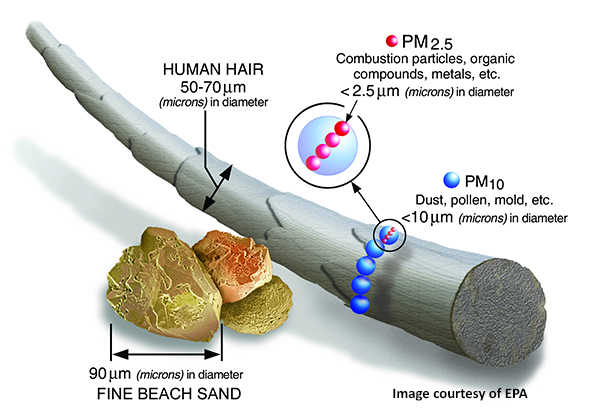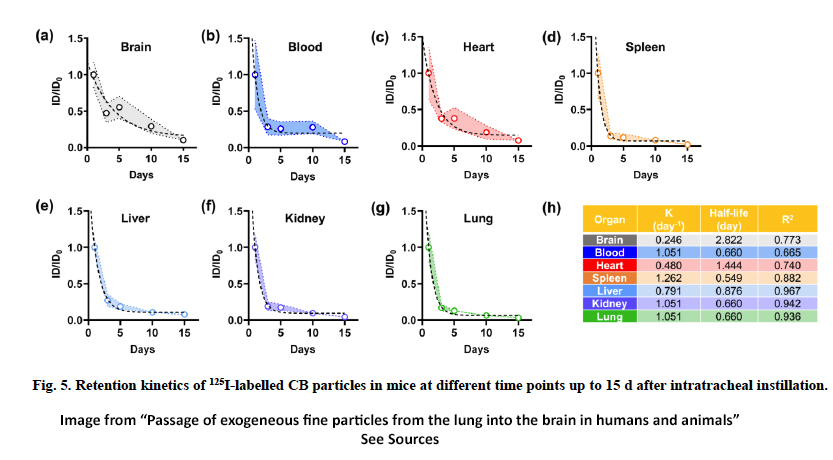It’s a small world
PM2.5 reflects a range of particulate matter that is smaller than 2.5 microns. For comparison, a human hair is at least 20 times larger, and a virus is 0.08 microns, 30 times smaller. Microplastics, one of our more recent  pollutants of concern, are any solid plastics that are 5000 microns or smaller – most research focuses on those 100-200 microns or micrometers in size. More germane to our discussion are ultrafine particles, part of that PM2.5 fraction and a bit larger than a virus, 0.1 microns or 100 nanometers (nm) – in some instances, they are referred to as aerosols.
pollutants of concern, are any solid plastics that are 5000 microns or smaller – most research focuses on those 100-200 microns or micrometers in size. More germane to our discussion are ultrafine particles, part of that PM2.5 fraction and a bit larger than a virus, 0.1 microns or 100 nanometers (nm) – in some instances, they are referred to as aerosols.
PM2.5 is usually described by its mass or weight [1]. Ultrafine particles are so much smaller that they contribute negligible mass to PM2.5, but there are many present and are best described by their numbers. These “physicochemical” properties of the ultrafine fraction of PM2.5 have two significant physiologic effects:
- They are light enough to travel deep into our lungs, where air exchange occurs at the interface of inhaled air and our bloodstream.
- They have a significant amount of surface area so that other biomolecules can stick to them.
Lastly, soot, a combination of predominantly pure or elemental carbon and organic carbon, carbon with other chemicals attached to it, make up the bulk of ultrafine particles. That organic carbon results from incomplete combustion or secondary conversion when elemental carbon reacts with organic compounds in the air.
Ultrafine particles as a Trojan Horse
Studies have found ultrafine particles in our bloodstream and tissue, like our hearts. That is not too surprising given ultrafine’s small size and their surface area, which allows them to stick to biomolecules that cells recognize, permitting “receptor mediated transport.” Ultrafine particles evade our immune system by being wrapped within these biomolecules – just as the Greeks were hidden within the Trojan Horse.
But the brain is a special organ; just ask it. And it is protected by what we refer to as the blood-brain barrier. Here the connections between the cells lining the blood vessels are very tight, and nothing can get in except through exchange within the cells making up the wall of the vessel. That is why some brain cancers are more difficult to treat – chemotherapy does not cross the blood-brain barrier. [2]
Given all of this, how might these ultrafine particles wind up in our central nervous system? There is evidence, using engineered nanoparticles, that we might inhale them through our nose – the olfactory nerves in the nose connect directly to our brain. And given their stickiness, ultrafines may Trojan Horse their way in; or their presence may damage the blood-brain barriers' tight connections, loosening them enough to allow the ultrafines in.
The Study
Researchers collected spinal fluid and blood from patients “who experienced brain diseases but had not received any previous brain surgery.” Two points, the spinal fluid is involved with the disposal of metabolic waste products and “exogenous components” from the brain, so the presence of ultrafine particles here indicates they are in our heads but on the way out. Second, there is a bias in the patient selection; they all have a brain disease, although what those diseases are is never indicated. That they have not had any previous brain surgery just means that any overt medical treatment has not contaminated the spinal fluid. However, contamination during spinal fluid collection cannot be ruled out. This study cannot draw a link between the presence of ultrafine particles and brain diseases; there is no way in this chicken-egg debate to know which came first.
Using a range of very sophisticated imaging, including electron microscopy and x-ray spectroscopy, they identified ultrafine particles in a third of the 25 patients they examined. [3] In addition to noting some particles that contained “components commonly found in our atmosphere,” iron, silicon, and calcium, they identified some amorphous particles (Trojan horses) that contain malayaite, a pigment used in the ceramic industry, as well as a titanium compound found once again in the ceramics industry and sunscreen. Here is another important finding, while they indeed found ultrafine particles, were they a result of these patients' workplace exposure?
“…the findings here likely reflect the occurrence of substantive numbers of exogeneous fine particles in human CSF in some patients, mostly from occupational exposures, and warrant follow-up epidemiological studies ….”
With some clinical evidence in hand, the researchers turned to an animal model to try and identify the mechanism of entry for those particles. To avoid the possibility of olfactory entry, they instilled a large amount of titanium oxide and elemental carbon “to simulate accumulated inhaled PM exposure” into mice's trachea (windpipe). Whether that simulation is accurate is another matter. Within 24 hours, there was evidence of injury to the lung's lining, the alveoli with “pronounced transmission,” of those particles across the air-blood barrier. Subsequently, some of these particles were found in the mice’s brains. The researchers found that the tight connections of the blood-brain barrier had been loosened and that those ultrafine particulate aggregates, the Trojan Horses, were located near the damaged areas – the particles “seeped” into the central nervous system.
 The mice did put up a defense as additional experiments with elemental carbon affixed to a radioactive tracer, again instilled into the trachea, demonstrated. The elemental carbon collected quickly in the kidneys, where it could be excreted as urine. Some were found in our organs, caught in the reticuloendothelial cells – cells designed to capture and remove particles from our bodies. And some were found, once again, in the central nervous system, which cleared the particles, but over a more extended period, more similar to the clearance by the heart than the blood.
The mice did put up a defense as additional experiments with elemental carbon affixed to a radioactive tracer, again instilled into the trachea, demonstrated. The elemental carbon collected quickly in the kidneys, where it could be excreted as urine. Some were found in our organs, caught in the reticuloendothelial cells – cells designed to capture and remove particles from our bodies. And some were found, once again, in the central nervous system, which cleared the particles, but over a more extended period, more similar to the clearance by the heart than the blood.
The researchers have identified a pathway for ultrafine particles to enter our central nervous system. Other studies have suggested that the direct route through the olfactory nerve is eightfold more efficient, but nonetheless, it seems that ultrafine particles can get in. Whether they are responsible for disease remains unknown, but at least there is an underlying physiological pathway for a linkage.
One last note, according to the EPA, PM2.5 in our atmosphere dropped below the national standard in 2008, and is currently 37% less than in 2000.
[1] From the point of view of physics, mass and weight are different, but for our purposes, they are the same.
[2] There has been some interesting work on using focused ultrasound to vibrate the brain's blood vessels to loosen up those tight connections and let chemotherapy in.
[3] The researchers identified ultrafine particles in only 1 of 26 individuals without “brain diseases.”
Source: Passage of exogeneous fine particles from the lung into the brain in humans and animals PNAS




